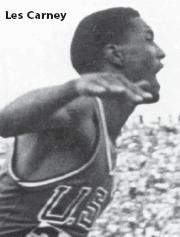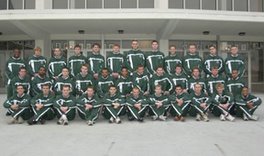From the Athens News:
National group threatens lawsuit over OU sport cuts
2007-04-19
Equity in Athletics, Inc. (EIA) announced yesterday afternoon that its Great Lakes Chapter has formally asked Ohio University to postpone its plans to eliminate four varsity sports. The group threatened to file suit against OU if the university doesn't comply with its demand.
EIA cited an April 17 letter that it sent to OU that refers to a lawsuit against the U.S. Department of Education in the U.S. District Court for Western Virginia "and its Great Lakes Chapter's intent to file a similar lawsuit over the OU cuts."
Earlier this year, OU announced that it was cutting its men's indoor and outdoor track teams, men's swimming and diving team, and women's lacrosse team. University officials said the cuts were both a money-saving move and a way to comply with federal Title IX gender-equity guidelines.
The decision provoked strong criticism among affected student-athletes and their parents, as well as supporters on campus.
In the news release issued yesterday afternoon, EIA President John Licata stated, "Sadly, schools across the country are making the same misguided, unnecessary and illegal decisions to cut men's teams and small-roster women's teams based on the wrong test for compliance with Title IX."
In both Virginia and Ohio, according to the release, EIA argues "that the 1975 Title IX regulations create an equal-opportunity standard, based on interest, with schools having the obligation to assess the interest of both genders. In a series of actions in 1979, 1996, 2003 and 2005, however, the federal government has created a rival standard of equal participation, based on enrollment."
EIA argues in the release that the post-1975 actions were both procedurally and substantively illegal. Therefore, according to the group, "Under EIA's interpretation of the Title IX regulations, OU's planned cuts are illegal," while the university's current alignment of teams complies with the law.
EIA's letter maintains that OU's sport cuts violate both Title IX and the U.S. Constitution and asks OU to postpone the cuts to allow EIA's litigation to resolve the appropriate standard for schools' athletic compliance in the federal Sixth Circuit.
According to EIA's Web site, the group "is a nonprofit coalition of athletes, coaches, parents, alumni, and fans who want to ensure broad-based and equitable athletic opportunities for all athletes, at all levels of competition."
An article yesterday in the Harrisonburg, Va. Daily News Record described EIA as "a group of 400 student athletes, coaches, parents and fans from across the United States, half of whom are affiliated with JMU (John Marshall University in Virginia).
The story is about EIA adding JMU to the lawsuit it filed last month against the U.S. Department of Education.
The NEWS received the news release at deadline yesterday, and a spokesman for OU Intercollegiate Athletics said that the department was unprepared to comment on such short notice.
Here's an article about the EIA lawsuit against James Madison U. from Inside Higher Ed:
More Pressure to Protect Men’s Teams
An organization challenging the way the Education Department enforces Title IX has told James Madison University to either stand with them or face a lawsuit. The threat is the latest fallout from James Madison’s September decision to cut 10 teams — a move that has renewed criticism from advocates for men’s athletics that Title IX of the Education Amendments of 1972 is being used to hurt their teams.
Related stories
“When JMU announced the cuts ... they said, ‘We don’t want to do this, it’s not about the $550,000, it’s because we have to, because we’re going to get sued,’” said John Licata, president of Equity in Athletics, Inc., an organization of about 350 to 400 coaches, students, parents and alumni (among others) formed in the wake of the James Madison athletic cuts. If that’s truly the case, said Licata, the university should postpone the cuts – scheduled to take effect July 1 – pending a ruling in a lawsuit Equity in Athletics filed March 20 against the U.S. Department of Education. The group charges that the agency’s enforcement standards are unlawful on both a procedural and substantive level.
In lieu of the university postponing the cuts on its own, Licata said the group will also sue James Madison on the basis that by following the Education Department’s rules of enforcement, the university has engaged in a discriminatory practice. Equity in Athletics will also seek an immediate court order that the cuts be put on hold while the case proceeds.
The group has asked the university to respond to its ultimatum by today.
“What we believe and what people I believe smarter than me believe is that institutions have taken this vehicle called Title IX and have taken liberties and interpretations of it to craft reasons to terminate programs,” Licata said in a Friday interview, acknowledging that even if the group wins the suit, JMU would still be at liberty to offer — and not offer — sports at will. “JMU has said, ‘Hey, we don’t want to do this; we have to do it.’ So if we take that reason out of it, if we’re successful with this, then we’ll find out what their true intentions are.” (At the university, questions of ulterior motives and possible scapegoating are particularly acute, as, in the immediate aftermath of the announcement, the university’s own Title IX consultant disputed the university’s argument that the cuts were primarily motivated by Title IX).
The university’s Board of Visitors met Friday afternoon, but a university spokesman declined to say whether the board considered the group’s demands, and declined to offer any other comment due to possible litigation. Licata said however that his group’s attorney received word late Friday from JMU’s counsel that the university would be in touch today, which Licata described as a “reasonable response.” While a letter sent to JMU officials gives them until today to answer, Licata said Equity in Athletics would agree to a minor extension of the deadline if college officials demonstrate a willingness to negotiate.
JMU cut seven men’s sports and three women’s sports in September, with one board member terming the cuts its “Title IX compliance program.” Officials repeatedly said the decision was driven by a need to bring the university’s athletic participation, at about 50 percent male and 50 percent female, in line with the student demographics: about 61 percent female, and 39 percent male.
“We would not have done it if not for Title IX,” a JMU spokesman told Inside Higher Ed in October. “There’s just about no way we could add more women’s programs and afford it and be in compliance.”
Equity in Athletics supports Title IX and equal opportunity in college sports, Licata stressed, but “wants to find a more reasonable interpretation that protects women without harming men.” In the suit filed against the Education Department in U.S. District Court, the group charges that the three-pronged compliance test currently in place is unlawful, and asks for a declaratory judgment stipulating that Title IX “authorize only rules that effectuate Title IX’s prohibition of intentional discrimination and do not authorize rules that create a disparate-impact standard, affirmative-action mandate or enrollment-based participation quota.”
Under the current three-pronged test, institutions can comply by ensuring gender participation in athletics proportionally mirrors male/female representation within the student body, by demonstrating a history of adding new sports, or by meeting existing student demand, as gauged by interest surveys. Advocates for women’s sports, such as the Women’s Sports Foundation, dispute concerns about quotas. They point out that two non-numerical tests can also be used, and argue that universities that feel forced to adopt the so-called proportionality standard usually are in that situation only because they have neglected their responsibilities toward women’s sports for so long that they can no longer comply by gradually adding sports or proving they have met interest.
Many opponents of the proportionality prong, however, argue that proportionality is the only sure-fire way institutions can comply without fear of getting sued. One of the more prominent opponents, the College Sports Council, released data on Thursday indicating that many more men’s teams have been eliminated than National Collegiate Athletic Association statistics typically suggest. The group blames the declines on Title IX’s proportionality prong and what the group calls an emphasis on quotas.
Tuesday, April 24, 2007
Subscribe to:
Post Comments (Atom)




















1 comment:
Post a Comment